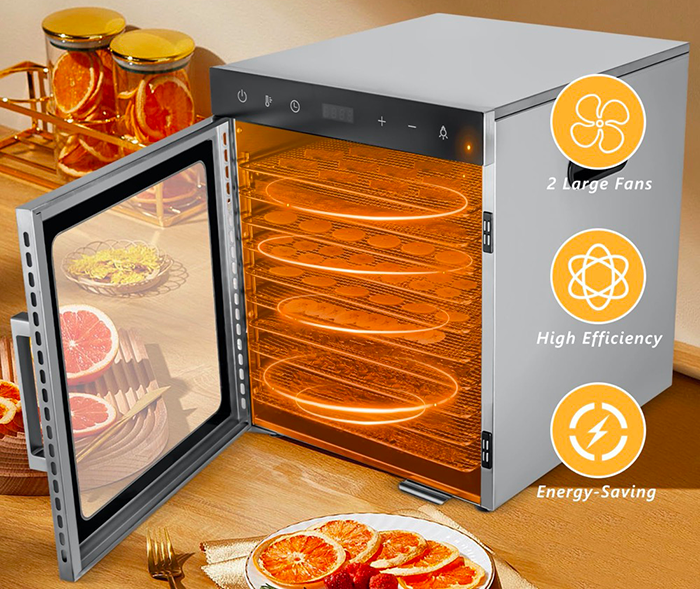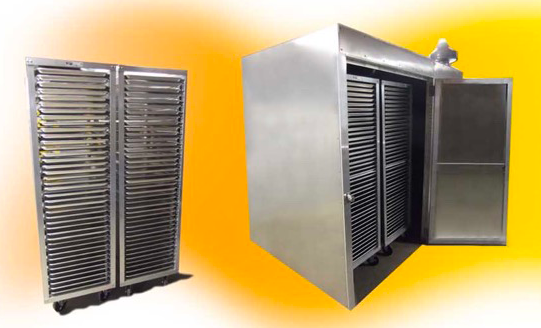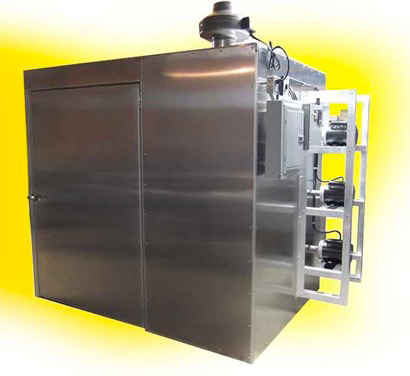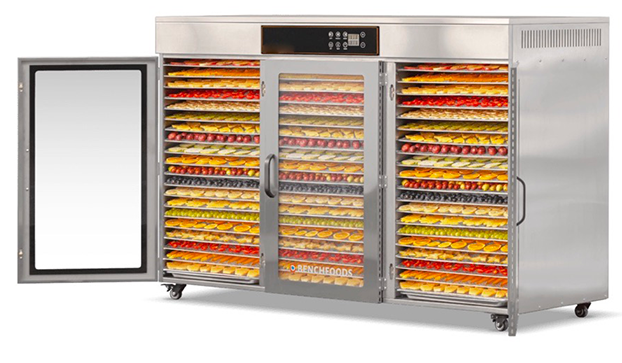
Content Menu
● Introduction
● Understanding Food Dehydrators
>> How Food Dehydrators Work
● Benefits of Using Energy Efficient Heat Pump Dryers
● Key Features to Look for in a Heat Pump Dryer
● Comparison of Heat Pump Dryers with Traditional Dryers
● Selecting the Right Food Dehydrator
● Maintenance Tips for Food Dehydrators
● Common Applications of Food Dehydrators
● Innovations in Heat Pump Technology
● Conclusion
● Frequently Asked Questions
>> 1. What is a heat pump dryer?
>> 2. How does a heat pump dryer differ from a conventional dryer?
>> 3. What types of foods can be dried using a heat pump dryer?
>> 4. Are there any specific maintenance requirements for heat pump dryers?
>> 5. How can I determine if a heat pump dryer is right for my business?
Introduction
In today's world, energy efficiency is a critical consideration for both consumers and manufacturers. As a leading factory producing food dehydrators in China, we understand the importance of energy-efficient appliances in the food processing industry. This article will explore the various aspects of food dehydrators, particularly focusing on the most energy-efficient heat pump dryers available in the market. We will cover their benefits, features, and how they compare to traditional drying methods. Additionally, we will provide insights into selecting the right food dehydrator for your needs.

Understanding Food Dehydrators
Food dehydrators are essential tools in food preservation. They work by removing moisture from food, which prevents spoilage and extends shelf life. The drying process involves circulating warm air around the food, effectively lowering its water content without cooking it.
How Food Dehydrators Work
Food dehydrators use a combination of heat and airflow to evaporate moisture. The basic components include:
- Heating Element: Provides the necessary warmth to facilitate drying.
- Fan: Circulates air evenly across all trays, ensuring uniform drying.
- Trays: Where the food is placed for drying.
- Thermostat: Regulates temperature to maintain optimal drying conditions.
The most energy-efficient heat pump dryers incorporate advanced technology that minimizes energy consumption while maximizing drying performance.
Benefits of Using Energy Efficient Heat Pump Dryers
Energy-efficient heat pump dryers have several advantages over conventional dryers:
- Lower Energy Consumption: These dryers utilize heat pump technology, which can reduce energy usage by up to 60% compared to traditional electric dryers.
- Consistent Drying: They maintain consistent temperatures, which helps preserve the quality of the food being dried.
- Environmentally Friendly: By using less energy, they contribute to lower carbon emissions and are more sustainable for long-term use.
- Versatility: Suitable for a wide range of products including fruits, vegetables, meats, and herbs.
- Enhanced Flavor Retention: Heat pump dryers operate at lower temperatures than conventional methods, which helps retain the natural flavors and nutrients of the food.
Key Features to Look for in a Heat Pump Dryer
When choosing the most energy-efficient heat pump dryer, consider the following features:
- Energy Rating: Look for models with high energy efficiency ratings to ensure lower operational costs.
- Temperature Control: Accurate temperature settings allow for optimal drying conditions tailored to different types of food.
- Airflow Design: Efficient airflow systems enhance drying speed and uniformity.
- Capacity: Choose a dryer that meets your production needs without wasting energy on excess capacity.
- Insulation: Well-insulated units retain heat better, reducing energy loss during operation.
- User-Friendly Controls: Intuitive controls and programmable settings can make operation easier and more efficient.

Comparison of Heat Pump Dryers with Traditional Dryers
| Feature | Heat Pump Dryer | Traditional Dryer |
|-----------------------------|-------------------------------------|-------------------------------------|
| Energy Efficiency | High (up to 60% less) | Low (high energy consumption) |
| Drying Temperature | Adjustable and precise | Often fixed and high |
| Environmental Impact | Lower carbon footprint | Higher emissions |
| Cost of Operation | Reduced electricity bills | Higher ongoing costs |
| Product Quality Preservation | Maintains flavor and nutrients | Can cook or degrade quality |
Selecting the Right Food Dehydrator
Choosing the right food dehydrator involves several considerations:
1. Intended Use: Determine what types of foods you plan to dehydrate—fruits, vegetables, meats, or herbs.
2. Volume Needs: Assess how much product you need to dry at one time; larger operations may require industrial-sized models.
3. Space Availability: Ensure you have adequate space for installation and operation of the dehydrator.
4. Budget: Consider both initial costs and long-term savings from reduced energy consumption.
5. Brand Reputation: Research brands known for their reliability and customer service support.
6. Warranty and Support: Look for manufacturers that offer good warranties and customer support to assist with any issues that may arise during operation.
7. Additional Features: Some models come with additional features such as timers, digital displays, or even smartphone connectivity which can enhance usability.
Maintenance Tips for Food Dehydrators
To ensure longevity and efficiency in your food dehydrator:
- Regularly clean trays and surfaces to prevent buildup of residues.
- Check seals and insulation periodically to maintain energy efficiency.
- Follow manufacturer guidelines for maintenance schedules.
- Inspect electrical components regularly for any signs of wear or damage.
- Store your dehydrator in a dry place when not in use to prevent moisture buildup that could affect performance.
Common Applications of Food Dehydrators
Food dehydrators are widely used in various industries beyond home kitchens:
- Commercial Food Production: Businesses involved in snack production often use dehydrators to create dried fruits, vegetable chips, or jerky products.
- Herbal Medicine Production: Herbalists utilize dehydrators to preserve medicinal plants while retaining their active compounds.
- Pet Food Manufacturing: Many pet food companies dehydrate ingredients like meat or vegetables to create nutritious pet treats.
- Emergency Preparedness: Dehydrated foods are popular among preppers as they have long shelf lives and are lightweight for storage.
Innovations in Heat Pump Technology
Recent advancements in heat pump technology have led to even greater efficiency and performance improvements:
- Smart Technology Integration: Many modern dehydrators now come equipped with smart technology that allows users to control settings remotely via smartphone apps. This feature can enhance convenience by allowing monitoring from anywhere.
- Advanced Sensors: Newer models may include sensors that automatically adjust temperature and humidity levels based on real-time conditions inside the dryer. This ensures optimal drying without user intervention.
- Eco-Friendly Refrigerants: The latest heat pump dryers often utilize eco-friendly refrigerants that have less environmental impact compared to traditional options.
Conclusion
Investing in an energy-efficient heat pump dryer is not only beneficial for preserving food quality but also contributes significantly to reducing operational costs and environmental impact. By understanding how these machines work and what features to look for, businesses can make informed decisions that align with their sustainability goals while enhancing productivity. The transition towards using heat pump technology represents a significant step forward in both efficiency and environmental responsibility within the food processing industry.

Frequently Asked Questions
1. What is a heat pump dryer?
A heat pump dryer is an energy-efficient appliance that uses heat pump technology to dry foods by removing moisture through controlled airflow and temperature settings.
2. How does a heat pump dryer differ from a conventional dryer?
Heat pump dryers are significantly more energy-efficient than conventional dryers, using up to 60% less electricity while providing consistent drying temperatures without cooking the food.
3. What types of foods can be dried using a heat pump dryer?
Heat pump dryers can effectively dry a variety of foods including fruits, vegetables, meats, herbs, and even pet treats while preserving their nutritional value.
4. Are there any specific maintenance requirements for heat pump dryers?
Regular cleaning of trays and surfaces is essential. Additionally, checking seals and insulation helps maintain efficiency over time.
5. How can I determine if a heat pump dryer is right for my business?
Consider your intended use, volume needs, available space, budget constraints, and brand reputation when selecting a heat pump dryer that suits your business requirements.












